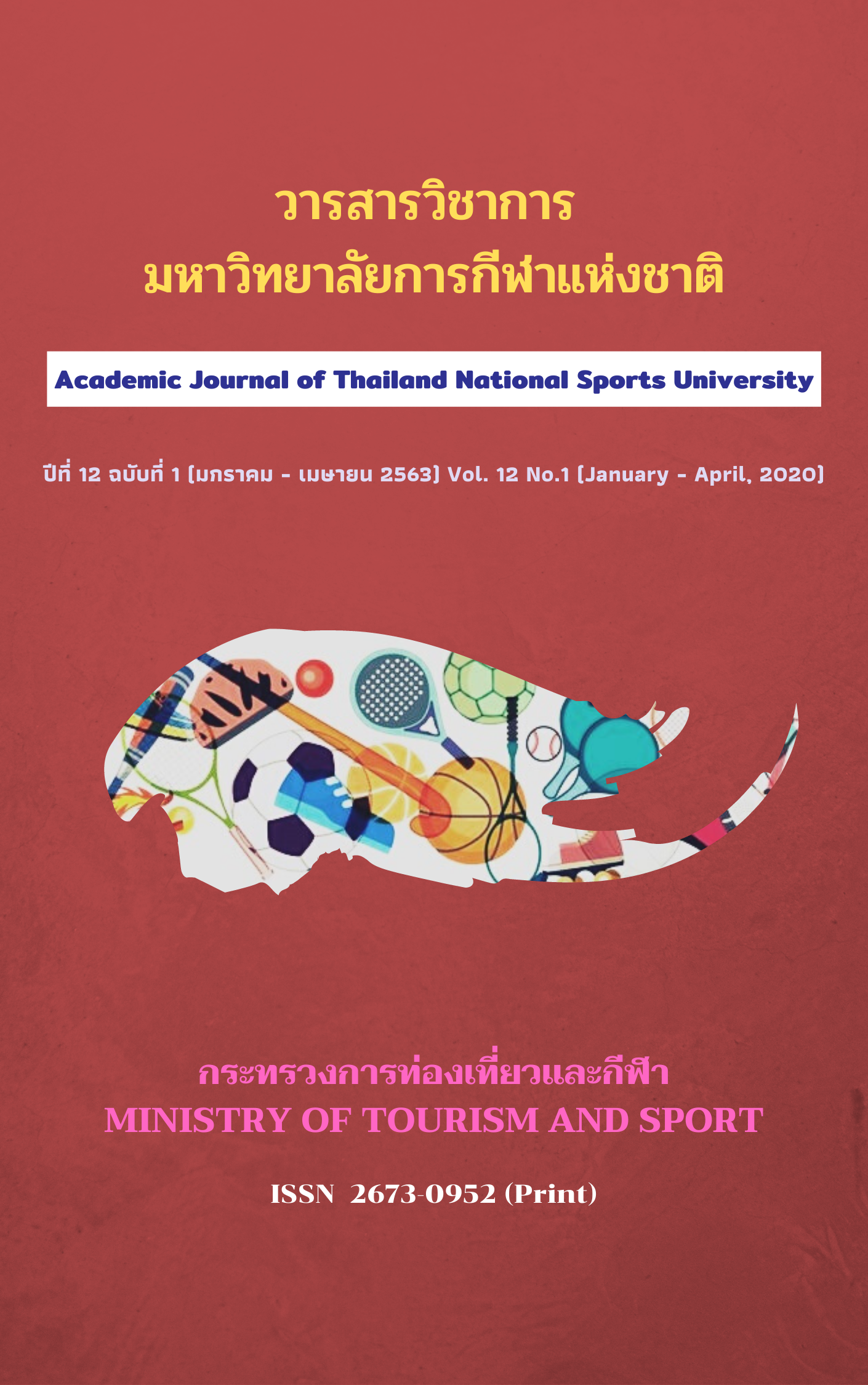ผลของโปรแกรมการออกกำลังกายด้วยไม้พลองที่มีผลต่อความอ่อนตัวของกล้ามเนื้อและองศาการเคลื่อนไหวของข้อต่อของนักศึกษาชายไทย ในมหาวิทยาลัย
Main Article Content
บทคัดย่อ
วัตถุประสงค์ เพื่อศึกษาผลของโปรแกรมการออกกำลังกายด้วยไม้พลองที่มีผลต่อความอ่อนตัวและองศาการเคลื่อนไหวของข้อต่อของนักศึกษาชายในมหาวิทยาลัย โดยกลุ่มตัวอย่างเป็นอาสาสมัครนักศึกษาชายอายุระหว่าง 19 – 20 ปี สาขาวิทยาศาสตร์การกีฬา คณะวิทยาศาสตร์ มหาวิทยาลัยราชภัฏอุดรธานี ที่กำลังศึกษาในปีการศึกษา 2560 จำนวน 30 คน ทำการทดลองด้วยโปรแกรมการออกกำลังกายด้วยไม้พลอง จำนวน 9 ท่า เป็นระยะเวลา 6 สัปดาห์ สัปดาห์ละ 3 วัน วันละ 40 นาที ทำการทดสอบก่อนและหลังการฝึก โดยใช้เครื่องเครื่องวัดความอ่อนตัว (Sit and Reach) และเครื่องวัดองศาการเคลื่อนไหวของข้อต่อ (Goniometer) ทำการวิเคราะห์ข้อมูลโดยหาค่าเฉลี่ย ส่วนเบี่ยงเบนมาตรฐาน และทดสอบสมติฐานโดยการหาค่าที (t-test) ที่ระดับความมีนัยสำคัญทางสถิติที่ระดับ .05 ผลการวิจัย พบว่า ค่าเฉลี่ยและส่วนเบี่ยงเบนมาตรฐานของการกลุ่มทดลอง ก่อนการฝึกและหลังการฝึก ความอ่อนตัวของกล้ามเนื้อหลังส่วนล่าง และกล้ามเนื้อต้นขาด้านหน้า และองศาการเคลื่อนไหวของข้อไหล่และข้อสะโพก มีความแตกต่างกันอย่างมีนัยสำคัญทางสถิติที่ระดับ .05 สรุปผลการวิจัย พบว่า การออกกำลังกายด้วยไม้พลองสามารถส่งเสริมการออกกำลังกายสำหรับนักศึกษาในสถานศึกษาได้
Article Details
บทความที่ได้รับการตีพิมพ์เป็นลิขสิทธิ์ของวารสารวิชาการ มหาวิทยาลัยการกีฬาแห่งชาติ ข้อความที่ปรากฏในบทความแต่ละเรื่องในวารสารวิชาการเล่มนี้ เป็นความคิดเห็นส่วนตัวของผู้เขียนแต่ละท่านไม่เกี่ยวข้องกับวารสารวิชาการมหาวิทยาลัยการกีฬาแห่งชาติ แต่อย่างใด ความรับผิดชอบองค์ประกอบทั้งหมดของบทความแต่ละเรื่องเป็นของผู้เขียนแต่ละท่าน หากมีความผิดพลาดใดๆ ผู้เขียนแต่ละท่านจะรับผิดชอบบทความของตนเองแต่ผู้เดียว
เอกสารอ้างอิง
Aukkarapoom Charuphakorn, and Pornpilai Lertwicha. (2007). Learning Brain. Bangkok: Institute of Learning Science.
Bureau of Health Promotion, Department of Health, Ministry of Public Health. (2000). A Guide to Exercise for Health. Bangkok: Veterans Relief Organization printing house.
Chanchai Khuntisiri and Suriyun Suwankarn. (2014). Manual of Mi – Plong Exercise. Kasetsart University.
Kattika Thanakwang, Pongsai Kantasen, and Rattanakorn Yotinn. (2012). Application of wooden clubs to the traditional ‘Mong Serng’ dance of Nan Province: Development and testing of its effectiveness and impact as an exercise program on elderly people’s physical performance. Thai Journal of Nursing Council, 27(2), 81-3.
Mongkol Fangsaken. (2006). Exercise with Stretching for Health and Sports. Bangkok: Chulalongkorn University Press.
Nikorn Yasamorn & Dussadee Luecha. (2012). Effects of Mi-plong exercise on community physical fitness, Nong Khu Phatthana tumbon, Kut Sak Cho Sub-district, Kantharawichai District, Maha Sarakham Province. The Institute of Physical Education Maha Sarakham.
Powers, S. K., and Dodo, S, L. (1999). The Essentials of Total Fitness: Exercise, Nutrition, and Wellness. Boston, MA: Allyn and Bacon.
Sombat Karnjanakit. (1998). Exercise Behavior: Reviewing Knowledge, Situations, and Related Factors under the Project of Continuing Thai Culture to Health. Bangkok: Veterans' Organization printing house.
Sports Authority of Thailand. (1995). Sport and Health Manual for Government Officials. Bangkok.
Sriruen Kaewkangwan. (2006). Psychology of Life Development at All Ages. Bangkok: Thammasat University.
Teerasak Arpawattanasakun. (2009). Science to Practice Sports. Bangkok: Chulalongkorn University Press.
Thepsuda Rungsang, Suree Chanmoree, Prapapen Suwan, and Mayuna Srisupanan. (2018). Effectiveness of participatory health promotion program for the elderly in Seek District, Ang Thong Province. Journal of the College of Nursing and Public Health, 5(2), 30 - 45.
Wuest, D.A. and Bucher, A.C. (1991). Foundations of Physical Education and Sports. Delhi, B I Publications.


